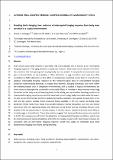Files in this item
Breeding limits foraging time : evidence of interrupted foraging response from body mass variation in a tropical environment
Item metadata
| dc.contributor.author | Nwaogu, Chima J. | |
| dc.contributor.author | Dietz, Maurine W. | |
| dc.contributor.author | Tieleman, B. Irene | |
| dc.contributor.author | Cresswell, Will | |
| dc.date.accessioned | 2018-01-19T00:31:33Z | |
| dc.date.available | 2018-01-19T00:31:33Z | |
| dc.date.issued | 2017-04 | |
| dc.identifier | 245778926 | |
| dc.identifier | 8bfe0bee-c71d-4be8-9c46-66fa0b665f50 | |
| dc.identifier | 85010703395 | |
| dc.identifier | 000403146600012 | |
| dc.identifier.citation | Nwaogu , C J , Dietz , M W , Tieleman , B I & Cresswell , W 2017 , ' Breeding limits foraging time : evidence of interrupted foraging response from body mass variation in a tropical environment ' , Journal of Avian Biology , vol. 48 , no. 4 , pp. 563-569 . https://doi.org/10.1111/jav.01132 | en |
| dc.identifier.issn | 0908-8857 | |
| dc.identifier.other | ORCID: /0000-0002-4684-7624/work/60426956 | |
| dc.identifier.uri | https://hdl.handle.net/10023/12514 | |
| dc.description | Funds were received from the Ubbo Emmius grant, Univ. of Groningen and also from the Univ. of St Andrews. | en |
| dc.description.abstract | Birds should store body reserves if starvation risk is anticipated; this is known as an ‘interrupted foraging response’. If foraging remains unrestricted, however, body mass should remain low to limit the predation risk that gaining and carrying body reserves entails. In temperate environments mass gain in female birds during breeding is often attributed to egg formation and mass loss after incubation to flight adaptation or the effect of reproductive workload, rather than as a result of an adaptive interrupted foraging response to the limited foraging time or unpredictable foraging conditions that breeding demands. In tropical environments, foraging conditions vary more within the breeding season than in temperate environments, and so studies in tropical environments are more suited to decouple the potentially confounded effects of increase in body reserves versus egg formation on the body mass of breeding birds. In this study, we test whether breeding results in an interrupted foraging response in a tropical savannah system using body mass data collected over a 15-year period from female Common Bulbuls Pycnonotus barbatus. This species breeds both in the wet and dry season, despite fewer resources being available in the dry season. Breeding stage predicted female body mass: body mass peaked abruptly during incubation, but was not closely associated with the egg-laying stage, and declined during brood rearing. Breeding females were heavier in the dry season than in the wet season. In the dry season, heavier birds were more likely to incubate eggs or brood chicks. These observations suggest that increased body reserves are required to buffer the consequence of limited foraging time or impoverished foraging conditions, which may be most pronounced during incubation and in the dry season, respectively. Such mass increases are consistent with an interrupted foraging response, which may apply to temperate zone birds experiencing foraging restrictions during breeding. | |
| dc.format.extent | 7 | |
| dc.format.extent | 541051 | |
| dc.language.iso | eng | |
| dc.relation.ispartof | Journal of Avian Biology | en |
| dc.subject | Body reserves | en |
| dc.subject | Breeding status | en |
| dc.subject | Food availability | en |
| dc.subject | Foraging unpredictability | en |
| dc.subject | Reproduction | en |
| dc.subject | Starvation-predation risk | en |
| dc.subject | Tropical seasonal variation | en |
| dc.subject | Tropical birds | en |
| dc.subject | QH301 Biology | en |
| dc.subject | QL Zoology | en |
| dc.subject | NDAS | en |
| dc.subject.lcc | QH301 | en |
| dc.subject.lcc | QL | en |
| dc.title | Breeding limits foraging time : evidence of interrupted foraging response from body mass variation in a tropical environment | en |
| dc.type | Journal article | en |
| dc.contributor.institution | University of St Andrews. School of Biology | en |
| dc.contributor.institution | University of St Andrews. Scottish Oceans Institute | en |
| dc.contributor.institution | University of St Andrews. Institute of Behavioural and Neural Sciences | en |
| dc.contributor.institution | University of St Andrews. St Andrews Sustainability Institute | en |
| dc.contributor.institution | University of St Andrews. Centre for Biological Diversity | en |
| dc.identifier.doi | 10.1111/jav.01132 | |
| dc.description.status | Peer reviewed | en |
| dc.date.embargoedUntil | 2018-01-18 |
This item appears in the following Collection(s)
Items in the St Andrews Research Repository are protected by copyright, with all rights reserved, unless otherwise indicated.

